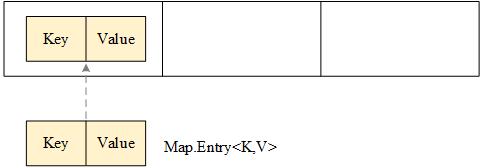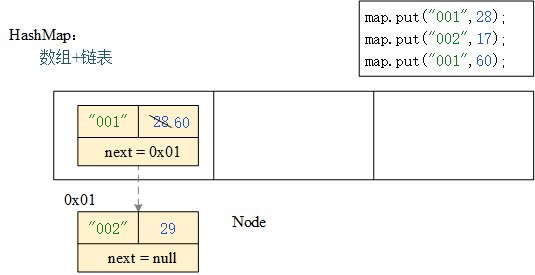Map mapping
-
public interface Map<K,V>
-
An object that maps keys to values. A mapping cannot contain duplicate keys; Each key can be mapped to at most one value.
-
Type parameter:
-
- K - the type of key maintained by this mapping
- V - type of mapped value
-
Implementation classes: HashMap, Hashtable, LinkedHashMap
-
Summary:
- Map stores key value pairs and the mapping relationship between them
- The key of Map cannot be duplicate
- Each key in the Map can only correspond to one value
method
-
V put(K key, V value): associate the specified value with the specified key in this map (optional operation).
-
If the current key already exists in the map, calling the put method to add will overwrite the previous Value value;
-
If there is no currently added key in the map, the return value is null; If the current key already exists in the map, the return value is the overwritten value;
-
-
void clear(): removes all mapping relationships from this mapping (optional).
-
boolean containsKey(Object key): returns true if the mapping contains the mapping relationship of the specified key.
-
boolean containsValue(Object value): returns true if this mapping maps one or more keys to the specified value.
-
V get(Object key): returns the value mapped by the specified key; Returns null if the mapping does not contain a mapping relationship for the key
-
boolean isEmpty(): returns true if the mapping does not contain a key value mapping relationship.
-
Set < k > keyset(): returns the set view of the keys contained in this map
The reason why the return value is a Set set is that the key of the Map is unique
-
Collection < V > values(): returns the collection view of the values contained in this map
-
V remove(Object key): if there is a key mapping relationship, remove it from this mapping (optional operation).
-
int size(): returns the number of key value mapping relationships in this mapping.
-
Set < map. Entry < K, V > > entryset(): returns the set view of the mapping relationship contained in this mapping.

public class MapDemo2 {
public static void main(String[] args) {
// Object to create Map
Map<String,Integer> map = new HashMap<String,Integer>();
// put() add element
System.out.println(map.put("001",28)); // null
System.out.println(map.put("002",17)); // null
System.out.println(map.put("001",60)); //28
// No error is reported during compilation. If it is repeated, value will be overwritten
// Override toString() Key = Value
System.out.println(map); // {001=60, 002=17}
// containsKey()
System.out.println(map.containsKey("002")); // true
// containsValue()
System.out.println(map.containsValue(28)); // false
// equals()
Map<String, Integer> copyMap = new HashMap<String,Integer>();
copyMap.putAll(map);
System.out.println(map.equals(copyMap)); // true
// get(key)
int num = map.get("001"); // Automatic unpacking
// int num1 = map.get("008"); // error
// map.get("008"); Return null
// Null. Intvalue() called during automatic unpacking -- > null pointer exception
System.out.println(map.get("008")); // null
// Set < k > keyset(): put the key value into a set
Set<String> keys = map.keySet();
// Values(): returns the set formed by values
Collection<Integer> col = map.values();
System.out.println(keys+"\n"+col);
// remove(key)
int tmp = copyMap.remove("001");
System.out.println(tmp);
// size()
System.out.println(map.size());
}
}
How to traverse Map
- Scheme I:
- KeySet get the Set of all key s
- Traverse Set set
- Get the corresponding value according to the value of the key
- Scheme II:
- Call entrySet() to get the Set of Entry objects representing Map key value pairs
- Traverse Set set
- Call the method of Entry to obtain the key and value respectively
- K getKey(): returns the key corresponding to this item.
- V getValue(): returns the value corresponding to this item.
// ergodic
// Scheme I:
// 1. keySet get the set of all key s
Set<String> keys = map.keySet();
// 2. Traverse the set
for (String str: keys){
// 3. Obtain the corresponding value according to the value of the key
System.out.println(str+"="+map.get(str));
}
// Scheme II:
// 1. Call entrySet() to get the Set of Entry objects representing Map key value pairs
Set<Map.Entry<String,Integer>> entries = map.entrySet();
// 2. Traverse Set
for (Map.Entry<String,Integer> entry : entries){
// 3. Call the Entry method to obtain the key and value respectively
System.out.println(entry.getKey() + "=" + entry.getValue());
}
// Simplified version
for(Map.Entry<String,Integer> entry: map.entrySet()){
System.out.println(entry.getKey() + "=" + entry.getValue());
}
HashMap
- Implementation based on array linked list

-
In order to improve the efficiency, the bottom layer of HashMap will be optimized accordingly
-
JDK1.8, when the chain length of the linked list exceeds 8, it will turn into a red black tree; After deleting the element, when the length of the linked list is less than 6, it returns to the linked list
-
The key of HashMap can be null, but there is only one; The value of HashMap can be null without limiting the number
-
Asynchronous threads are unsafe
-
Construction method:
-
HashMap(): construct an empty HashMap with default initial capacity (16) and default load (load, load) factor (0.75); When it exceeds 16 * 0.75 = 12, start capacity expansion and double the capacity each time
-
Method: no special method
Hashtable
- Start with the following version: JDK1.0
- Feature: key values cannot be null
- Synchronous thread safety
- Construction method
- Hashtable(): construct a new empty hash table with the default initial capacity (11) and load factor (0.75).
public class HashtableDemo {
public static void main(String[] args) {
// Create object Hashtable
Hashtable<String,Integer> table = new Hashtable<String, Integer>();
//
table.put("start",12); // Automatic packing
table.put("hello",15);
table.put("java",30);
System.out.println(table);
// ergodic
// 1. The iterator elements can only output value
Enumeration<Integer> ele = table.elements();
Enumeration<String> keys = table.keys();
while(keys.hasMoreElements()){
System.out.println(keys.nextElement() + "=" + ele.nextElement());
}
// 2. entrySet()
Set<Map.Entry<String,Integer>> entries = table.entrySet();
for(Map.Entry<String,Integer> entry: entries){
System.out.println(entry.getKey() + "=" + entry.getValue());
}
// Simplified version
for(Map.Entry<String,Integer> entry: table.entrySet()){
System.out.println(entry.getKey() + "=" + entry.getValue());
}
}
}
Differences between HashMap and Hashtable:
-
HashMap JDK1.2;Hashtable JDK1.0
-
The initial capacity of HashMap is 16 and the loading factor is 0.75; Capacity expansion: double the capacity each time;
The initial capacity of Hashtable is 11 and the loading factor is 0.75; Double + 1 for each expansion;
-
HashMap asynchronous thread is unsafe and efficient
HashTable synchronous thread safety, low efficiency
-
HashMap key value can be null, and only one key can be null
No Hashtable key value can be null
Note: both HashMap and Hashtable are out of order. LinkedHashMap can ensure the order of storage